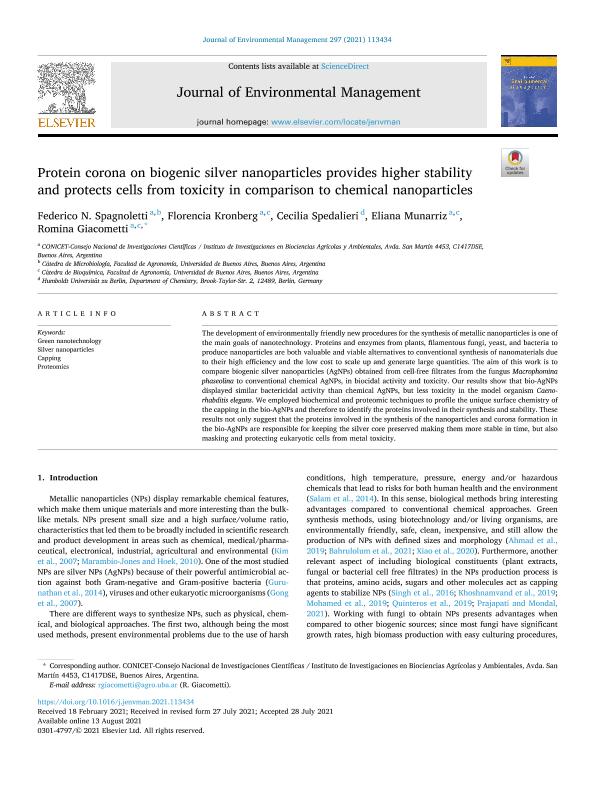Artículo
Protein corona on biogenic silver nanoparticles provides higher stability and protects cells from toxicity in comparison to chemical nanoparticles
Spagnoletti, Federico Nicolás ; Kronberg, Maria Florencia
; Kronberg, Maria Florencia ; Spedalieri, Ana Cecilia
; Spedalieri, Ana Cecilia ; Munarriz, Eliana Rosa
; Munarriz, Eliana Rosa ; Giacometti, Romina
; Giacometti, Romina
 ; Kronberg, Maria Florencia
; Kronberg, Maria Florencia ; Spedalieri, Ana Cecilia
; Spedalieri, Ana Cecilia ; Munarriz, Eliana Rosa
; Munarriz, Eliana Rosa ; Giacometti, Romina
; Giacometti, Romina
Fecha de publicación:
11/2021
Editorial:
Academic Press Ltd - Elsevier Science Ltd
Revista:
Journal of Environmental Management
ISSN:
0301-4797
Idioma:
Inglés
Tipo de recurso:
Artículo publicado
Clasificación temática:
Resumen
The development of environmentally friendly new procedures for the synthesis of metallic nanoparticles is one of the main goals of nanotechnology. Proteins and enzymes from plants, filamentous fungi, yeast, and bacteria to produce nanoparticles are both valuable and viable alternatives to conventional synthesis of nanomaterials due to their high efficiency and the low cost to scale up and generate large quantities. The aim of this work is to compare biogenic silver nanoparticles (AgNPs) obtained from cell-free filtrates from the fungus Macrophomina phaseolina to conventional chemical AgNPs, in biocidal activity and toxicity. Our results show that bio-AgNPs displayed similar bactericidal activity than chemical AgNPs, but less toxicity in the model organism Caenorhabditis elegans. We employed biochemical and proteomic techniques to profile the unique surface chemistry of the capping in the bio-AgNPs and therefore to identify the proteins involved in their synthesis and stability. These results not only suggest that the proteins involved in the synthesis of the nanoparticles and corona formation in the bio-AgNPs are responsible for keeping the silver core preserved making them more stable in time, but also masking and protecting eukaryotic cells from metal toxicity.
Palabras clave:
CAPPING
,
GREEN NANOTECHNOLOGY
,
PROTEOMICS
,
SILVER NANOPARTICLES
Archivos asociados
Licencia
Identificadores
Colecciones
Articulos(INBA)
Articulos de INST.DE INVEST. EN BIOCIENCIAS AGRICOLAS Y AMBIENTALES
Articulos de INST.DE INVEST. EN BIOCIENCIAS AGRICOLAS Y AMBIENTALES
Citación
Spagnoletti, Federico Nicolás; Kronberg, Maria Florencia; Spedalieri, Ana Cecilia; Munarriz, Eliana Rosa; Giacometti, Romina; Protein corona on biogenic silver nanoparticles provides higher stability and protects cells from toxicity in comparison to chemical nanoparticles; Academic Press Ltd - Elsevier Science Ltd; Journal of Environmental Management; 297; 113434; 11-2021; 1-12
Compartir
Altmétricas



